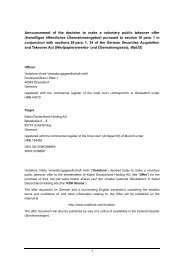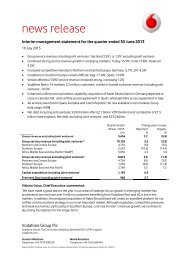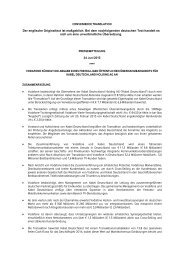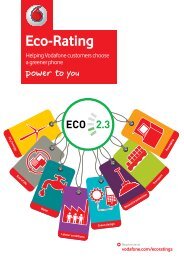Create successful ePaper yourself
Turn your PDF publications into a flip-book with our unique Google optimized e-Paper software.
Moving the debate forward • The Policy Paper Series • Number 8 • April 2008<br />
customers are drawn from the low-use group, hence it<br />
becomes efficient to raise call charges above marginal<br />
cost and lower rental charges.<br />
Conclusions<br />
The result showing a collusive outcome for two-way access<br />
under linear retail tariffs appears to have dominated the policy<br />
debate about two-way interconnection, in spite of (perhaps<br />
because of) the fact that this model is very simple and in spite<br />
of the fact that subsequent work in the area has shows that<br />
this conclusion appears to be special to the very restricted<br />
assumptions on which it is based. More realistic models do<br />
not produce this collusive result.<br />
This review has shown that:<br />
• If networks compete using rentals and call charges then<br />
the joint interest in driving up reciprocal access charges<br />
evaporates.<br />
• While LRT derived the profit neutrality result, it seems<br />
that this too is quite a special case. Allowing for either<br />
an endogenous market size or asymmetry in the sizes of<br />
networks creates an incentive for the networks to set a<br />
cost-based reciprocal access charge to maximise profits.<br />
However, my modelling indicates that this incentive may<br />
not, in practice, be very strong.<br />
• By contrast, it seems that differential on-net and off-net<br />
tariffs have a dramatic impact on the dynamics of the<br />
market. Commentators have noted that setting access<br />
charges above cost creates (positive) tariff mediated<br />
network externalities (TMNEs), which should favour<br />
larger networks. This view is static, however, and fails to<br />
account for the interaction of TMNEs and inter-network<br />
competition. Positive TMNEs make customers more<br />
profitable, and therefore more attractive for each network,<br />
giving all networks a strong incentive to increase their<br />
market share. This intensifies competition, ultimately<br />
reduces profits and increases consumer surplus. Given the<br />
chance, therefore, networks would choose low reciprocal<br />
access charges, possibly even “bill and keep” to reduce the<br />
intensity of competition for these subscribers, which would<br />
be to the detriment of the consumer surplus of subscribers.<br />
• The dynamic effect of TMNEs on the intensity of<br />
competition reveals that the idea of that the “waterbed”<br />
effect between access charges and profits is overly<br />
simplistic. This concept has usually been applied to<br />
the case of F2M access charges, but can equally be<br />
considered in the case of two-way access. What is critical<br />
to the effectiveness of the waterbed is not the intensity<br />
of competition in the retail market per se, but rather the<br />
extent to which changes in termination charges alter the<br />
intensity of retail competition. If access charges (one-way<br />
or two way) do not affect the intensity of competition then<br />
changes in termination charges would not be expected to<br />
alter the equilibrium level of profits. Hence the waterbed<br />
will be 100% effective regardless of the absolute level<br />
of competition in the outbound market. In the case of<br />
On-net Pricing in Mobile<br />
two-way access this is likely to be the case when on-net<br />
and off-net prices are uniform. In the presence of<br />
differentials however, higher access charges increase the<br />
intensity of competition, which means that networks<br />
pass on more than 100% of any movement in access<br />
charges. Although the consideration of waterbed effects<br />
in one-way access is outside the scope of this paper,<br />
these observations highlight how important it also is for<br />
regulators not to make simplistic assumptions about the<br />
relationship between F2M access charges and competition<br />
in the retail market.<br />
• Forcing up reciprocal access charges is an expensive way<br />
for a large operator to attempt to gain market share. In the<br />
absence of on-net/off-net differentials it seems to have<br />
a negligible effect on market share. With network price<br />
discrimination, on the other hand, it is possible for the<br />
larger network to increase its market share if it can force<br />
up the reciprocal access charges. However, unless it can<br />
completely exclude the competitor from the market it will<br />
simply doom itself to perpetual and significant damage to<br />
its profits in doing so. Moreover, it is not at all clear why a<br />
large incumbent attempting to adopt a predatory strategy<br />
would behave in this way. Modelling shows that, unless the<br />
access charge is substantially in excess of cost, it is almost<br />
certainly more cost effective for the dominant firm to cut<br />
retail prices than to force up reciprocal access charges (even<br />
if it has the power to do so) in order to build market share.<br />
• It is usually assumed that welfare will be maximised by<br />
cost-based access charges. However, the evidence I have<br />
reviewed shows that this need not be the case. First, in<br />
the presence of network externalities (for which an<br />
endogenous market size is a necessary but not sufficient<br />
condition) total welfare will be maximised by setting<br />
access charges above cost. Secondly, even without<br />
externalities setting access charges above cost can be an<br />
effective method of intensifying competition provided<br />
networks charge differential on-net and off-net tariffs.<br />
This does not increase total welfare, but does increase<br />
consumer surplus. Thus in many circumstances above-cost<br />
access charges have the effect of increasing the welfare of<br />
consumers, albeit at the expense of the networks.<br />
• I also find that allowing for the level of consumer<br />
participation in the market to be variable (i.e. a<br />
participation rate of less than 100% that varies depending<br />
on the prices offered) strengthens the effect on<br />
competition of above-cost access charges (and hence<br />
increases further the consumer benefit they create) but<br />
mitigates to some extent the desire for MNOs to reduce<br />
access charges to zero. It remains the case however, that<br />
MNOs would choose to set two-way access charges below<br />
cost so as to maximise profits.<br />
My conclusion is therefore that, on the basis of the types<br />
of models considered here, there is no incentive for mobile<br />
networks to set high reciprocal access charges. Furthermore, it<br />
does not appear that larger networks gain any particular<br />
advantage as a foreclosure strategy from attempting to force<br />
up reciprocal access charges.<br />
21

















